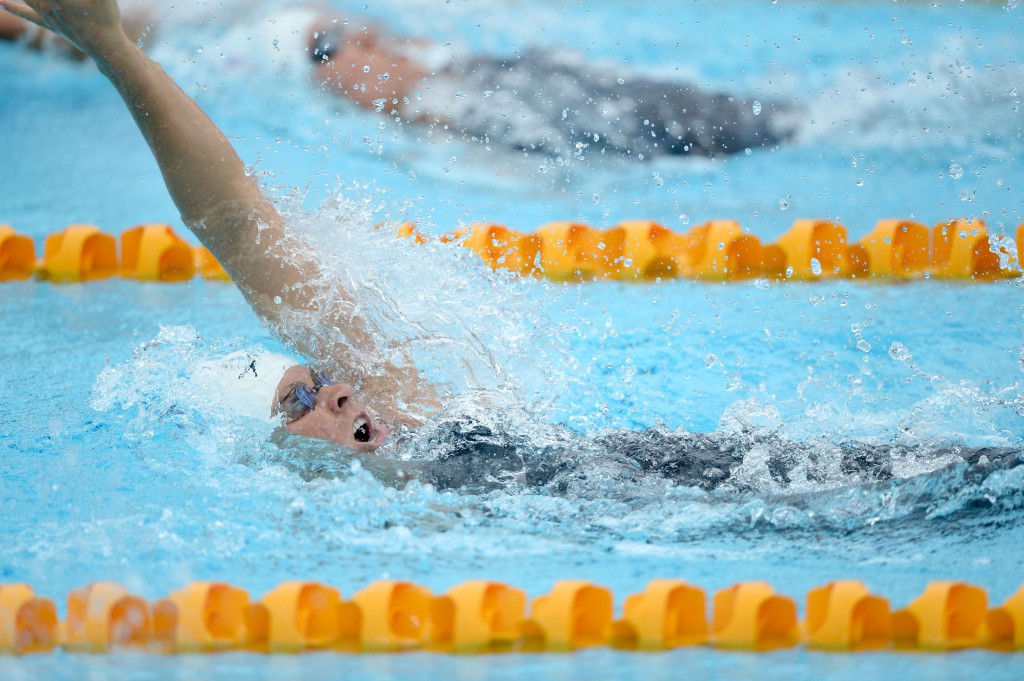10 Takeaways From Pan Pacific Championships That Can Help Your Swimming

Editorial coverage for the Pan Pacific Championships is proudly sponsored by Master Spas! For complete coverage of the Pan Pacific Championships, check out our event landing page.
Commentary by Wayne Goldsmith
GOLD COAST, Australia, August 23. THE 2014 Pan Pacs are on and there’s some fast swimming and tough racing here on Australia’s Gold (Cold?)) Coast. And there’s also plenty to learn from watching some of the world’s greatest swimmers up close doing what they do best.
Here’s ten things I’ve learned from the first two days of the meet that can really help you swim faster:
Streamline streamline streamline – Remember all those times your coach has yelled “streamline” during workouts? It’s time to start listening. Time and time again we’re seeing the Pan Pac medal winners not just winning the actual race, they’re also winning the “skills” race by streamlining longer, faster and with better form than the rest of the field. Watch and learn: Most of the Japanese swimmers are outstanding at streamlining, but check out the underwater form of their brilliant breaststrokers Watanabe and Koseki in the 100 breaststroke finals for women and men.
Turns turns turns – And just as importantly, remember that in practice every turn is a race turn. We’re seeing races won and lost just on turns. Swimmers with faster turns (and better streamlining skills) might get to the wall behind other swimmers but the quality of their skills sees them coming out ahead of their competitors. The lesson is clear: every turn in training counts. Watch and learn: Aussie Cameron McEvoy in the final of the men’s 100 free.
It ain’t over ’til it’s over – There are no medals being awarded here for the swimmer who is in front at the 90-metre mark. No one is gettin’ gold for being the “first to the flags.” Keep stroking and kicking and driving with everything you have until you feel your fingers touch the wall. Watch and learn: Michael Phelps’ finish in the heats of the 100 fly and Koseki’s final drive to the finish in the men’s 100 breast final.
Underwater really is fifth competitive swimming stroke – There’s fly, back, breast and free — and there’s also underwater swimming, the fifth competitive swimming stroke. The best swimmers here are good above and below the water. Watch and learn: Ryan Lochte anytime he swims.
Use the blocks – With the Omega fin starting blocks being used here and in all major swim meets around the world, we’re seeing swimmers explode off the blocks with more power and more drive than we’ve ever seen. Practice your starts every day and make sure you kick back hard and fast at the blocks – trying to “kick the blocks over” – every time you take off. Watch and learn: Brazilian breaststroker Felipe Franca da Silva. He’s scary fast and it all comes from the power of his start.
Be prepared – It’s cold here. And wet. And windy. Prepare to win anytime, anywhere and in any conditions by always choosing to train in tough conditions. Competitive swimming is not a handicap event. You have to win no matter what challenges, obstacles and problems are placed before you. Watch and learn: Emily Seebohm in the 100 backstroke final – conditions were terrible – especially for a backstroker – yet she swam fast and was under world record pace for most of the race.
Smooth is fast – Maybe we should rename 50- and 100-metre events because the word “sprint” doesn’t seem appropriate any more. The fastest swimmers in the world swim at maximum speed with relaxed, easy, smooth technique and their speed seems to be effortless. Watch and learn: Australia’s Sprint Queen Cate Campbell and South Korea’s Olympic Champion Taehwan Park who make super-fast look super easy.
Ya gotta be tough – No one hands you a gold medal for being a nice guy. You don’t win a medal because you’ve got the most expensive swimming cap. If you want to win you’ve got to get out in front and grab victory for yourself. It’s been interesting to note that in these tough conditions many of the world’s top swimmers are choosing to go out fast as a kind of challenge to the rest of the field. It’s like they’re saying: “Sure, these conditions are tough: but I’m tougher”. Watch and learn: Elizabeth Beisel in the 400 IM final – a tough swimmer who keeps on winning because she gets out in front and challenges her rivals to catch her if they can. And Jess Hardy – goes out hard and just keeps on going in the 100 breast: she gives no one else a chance.
Kicking is “kritical” – Every great swimmer we’ve seen so far is also a great kicker. Sometimes kick sets in training might seem a bit dull and a bit pointless, but when it comes down to the moments that really matter in races, it’s your legs that will pick you up and get you to the wall first. Watch and learn: Japanese IMer Kosuke Hagino, who does just about everything right. And Katie Ledecky in the final 50 of her 200 freestyle final.
Pacing is everything – Particularly in big races it’s easy to go out too hard, misjudge your pace and find yourself falling back through the field in the final 20 metres. Going out hard is fine – it’s often a winning strategy – but don’t do it on the spur of the moment or because you’re excited about being in a final. Practice pacing constantly in training and do everything in your race with a plan. Watch and learn: Katie Ledecky and Missy Franklin in all their races.
Being at a world class meet is exciting: it’s fun and it’s amazing and it’s also a great chance to learn from the best and learn new ways of swimming better and faster.
Wayne Goldsmith is a Swimming World Magazine contributor and world-renowned swim coach who has spoken at clinics and other engagements around the world.





Excellent advice…great encouragment..